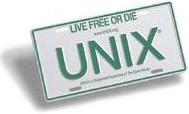UNIX System Home • The Single UNIX Specification • UNIX 03 • UNIX V7 • Mailing Lists • White Papers
UNIX System Home • The Single UNIX Specification • UNIX 03 • UNIX V7 • Mailing Lists • White Papers
What about all those "Flavors"? |
||

History & TimelineHistory of the UNIX License PlateThe Single UNIX SpecificationRegistered ProductsThe UNIX BrandWhat About All Those "Flavors"Version 2 of the Single UNIX SpecificationVersion 3 of the Single UNIX SpecificationVersion 4 of the Single UNIX SpecificationUNIX API TablesWhy This is Different |
Introduction Since it began to escape from AT&T's Bell Laboratories in the early 1970's, the success of the UNIX operating system has led to many different versions; Universities, research institutes, government bodies and computer companies all began using the powerful UNIX system to develop many of the technologies which today are part of the IT environment. Computer aided design, manufacturing control systems, laboratory simulations, even the Internet itself, all began life with and because of UNIX systems.
Soon all the large vendors, and many
smaller ones, were marketing their own, versions of
the UNIX system optimised for their own computer architectures
and boasting many different strengths and features. See the
Developed by Linus Torvalds, Linux is
a product that mimics the form and function of a UNIX system,
but is not derived from licensed source code. Rather, it was
developed independently; by a group of developers in an informal
alliance on the net. A major benefit is that the source code
is freely available (under the GNU copyleft), enabling
the technically astute to alter and amend the system; it also
means that there are many, freely available, utilities and specialist
drivers available on the net. Linux is a registered trademark of
Linus Torvalds.
Recent versions of Glibc include much functionality from the Single UNIX
Specification, Version 2 (for UNIX 98) and later.
BSDI is an independent company that
markets products derived from the Berkeley Systems Distribution
(BSD), developed at the University of California at Berkeley in
the 60's and 70's. It is the operating system of choice for
many Internet service providers. It is, as with Linux, not a
registered UNIX system, though in this case there is a common code heritage
if one looks far enough back in history.
IBM has been quietly working on its
mainframe operating system (formerly MVS) to add open interfaces
for some years. In September 1996, The Open Group announced that
OS/390 had been awarded the X/Open UNIX brand, enabling IBM to
identify its premier operating system to be marked UNIX 95.
This is a significant event as OS/390 is the first product to
guarantee conformance to the Single UNIX Specification, and therefore
to carry the label UNIX 95, that is not derived from the
AT&T/ SCO source code.
Microsoft® Windows NT
was developed as a completely new, state of the art, 32 bit operating
system. As such, it has no connection with the UNIX system source
code.
However, market demand for POSIX.1 , POSIX.2 has led to
developments by several companies of add-ons that provide
partial functionality. Should the functionality meet the requirements
of the UNIX brand then indeed it could become a registered UNIX system.
These are all registered UNIX products. To see the full list
of UNIX vendors and the current UNIX branded product register
select here.
|
|